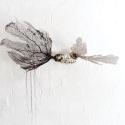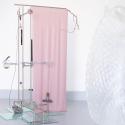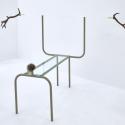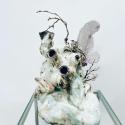Discipline
Conceptual
Digital / Light / Sound
Installation / Land / Site-specific
Kinetic/Mobile
Water
Material
Ceramic/Clay
Glass
Mixed media
Steel
Region
London
Europe
Biography
In her work, Margo Trushina explores the intersection of bioart and new feminist materialist ethics. Her living sculptures and environments reflect upon recent discoveries in neuroscience, biotechnology and ecology through the lens of personal bodily experiences.
In tune with speculative ethics of care, Trushina pursues direct interspecies relationships as her way to address current environmental challenges;- rising sea- levels , species extinction, outbreaks of zoonotic diseases and pathologic gene mutations. The artist offers a subjective material vision of these problems by creating fragile environments by tying together substances that come from different natures - such as steel and neon with corals and breast milk. Her fictional environments and sculptures reflect habitats and bodies affected by climate change that are still breathing, therefore calling for an ethical response.
Engaging with the diversity of agents entangled and intertwined with each other and their surroundings, she makes visible a variety of transcorporeal imprints in the bodies of others — humans and other animals, plants, water, light, soil, stones and fossils. To this purpose, she creates situations of intensive proximity to the other, allowing viewers to experience the transformative potential of actual and imagined touch (haptic visuality). In the artist’s view, such interactions actualise our almost neglected communication trajectories and promise to inspire new forms of perception, similar to what Laura U. Marks calls empathic nonunderstanding.
Living Space Margo Trushina X Playtronika Living Space, mixed-media, 2020 Commissioned by Cosmoscow Art Fair 2020 as a special project, supported by Ruinart Art Patronat Award In the Living Space series, the artist continues to explore the place of humanity in the environment from a posthumanist perspective. The project offers a symbolic interpretation of our present condition characterized by a radical climate change and an urgent need for finding new ways of being in the world together with other species. Living Space combines natural and artificial substances: plants, soil, metal, water, glass, ceramics, silicone, sounds and lights. Each hybrid sculpture has its own voice, which can be activated by human touch or movement. The initial soundscape for the installation is made out of field recordings and amplified by the audience presence. The sounds were created in collaboration Playtronica Lab, an art collective exploring the transition of touch to sound and the ability of sound to cause new interactions between people. Our brains are natural batteries generating electricity to operate. This feature of human corporeity inspired the artist to establish our connection with the natural world using sound as a medium. Applying electronic devices and software developed by Playtronica, Trushina connected humans and plants into one electrical circuit. This allowed the participants to extract sounds from flowers, herbs and trees, which in turn challenged the conventional perception of plants by exposing humans to the essential questions: what are we listening to and what are we made of? Living Space should be seen as an open ecosystem, an ongoing process of interspecies communication where plants and other organic subjects take on the leading role. The soundscape created in this intercommunion occupied a rainy jungle with waterfalls, rockpools and their inhabitants recreated by the artists in a gallery space. The project was powered by the Body. Earth. Ear workshop held by London-based artist Lina Lapelyte, exploring the notion of sound and the act of listening. The workshop encouraged alternative types of listening, relying not only on the hearing but also on multisensory experiences engaging more than brain intelligence distributed throughout our bodies. The series is inspired by the meeting with Emmanuel Coccia, an Italian philosopher and researcher of plant intelligence, author of The Life of Plants. Fascinated by the plants’ role in sustaining the environment and their capacity to perceive their surroundings with greater sensitivity than animals, Trushina started to work on the Living Space in Thailand during the first lockdown and went through several stages of research on plants before implementing the project in Moscow.



